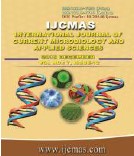


 National Academy of Agricultural Sciences (NAAS)
National Academy of Agricultural Sciences (NAAS)

|
PRINT ISSN : 2319-7692
Online ISSN : 2319-7706 Issues : 12 per year Publisher : Excellent Publishers Email : editorijcmas@gmail.com / submit@ijcmas.com Editor-in-chief: Dr.M.Prakash Index Copernicus ICV 2018: 95.39 NAAS RATING 2020: 5.38 |
Detection of somaclonal variation in tissue cultured plants is essential for conservation of elite varieties and also to avoid undesired characters. The genetic fidelity of in vitro regenerated Chrysanthemum cv. Pusa centenary, a commercially important cultivar was assessed using RAPD and ISSR markers. Regeneration was obtained via organogenesis and somatic embryogenesis from leaf and petal explants respectively. Murashige and Skoog (MS) media with different plant growth regulators (PGR) were used for in vitro experiments with leaf explants. Among the different PGR combinations used in MS media, 2,4-Dichlorophenoxyacetic acid (2,4-D) (1 mg L-1) and á¼€-naphthalene acetic acid (NAA) (1 mg L-1) along with 0.5 mg L-1of 6-benzylaminopurine (BAP) or Kinetin (Kin) was optimal for producing 83-93% callus induction from leaf explants. On transfer to light on MS media with BAP (0.5 mg L-1) and reduced auxins, the calli started turning green and proliferating into plantlets. Petal explants on the same media, produced direct somatic embryos within 10-14 days. On subculture, profuse production of somatic embryos with root and shoot poles was obtained. Nineteen primers (9 RAPD and 10 ISSR primers) produced 825 clear reproducible and scorable bands. While RAPD primers produced completely monomorphic bands with both leaf and petal regenerated plants in comparison to their mother plant, it was found that ISSR primers were able to detect variation in leaf callus derived plantlets. The plants regenerated via organogenesis from leaf explants were showing a variation of 0.66% with ISSR primers and plants regenerated from distinct somatic embryos of petal explants showed completely monomorphic bands with both RAPD and ISSR proving it’s true to type nature. These results indicate that in vitro culture process induces rearrangements at the DNA level and demonstrates discrepancies between the pathways involved in regeneration.
 |
 |
 |
 |
 |